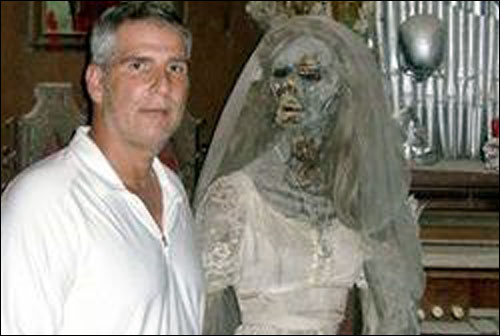During the weeks leading up to this year’s Halloween, The Nest Haunted House (rated the spookiest place in the nation by ABC‘s Good Morning America TV news show) will offer terror tailored to each visitor, thanks to an RFID-based system. That means a patron may see his or her name on a tombstone, view friends’ faces displayed on walls, seemingly in trouble, and hear a “serial killer” calling out to him or her.
The Nest—located at the Rawhide entertainment park, in Chandler, Ariz., approximately 30 miles south of Phoenix—takes visitors through a 55,000-square-foot “haunted house” in which they are stalked by a serial killer known as “Killer Kell.” Steve Kopelman, The Nest’s producer, says that a few years ago, he noticed that “if, by chance, we figure out the patron’s name, it enhances the experience tenfold.” Since then, Kopelman has been seeking ways in which to individualize the experience at his haunted houses. He looked into RFID-based experiences, and was interested in adapting a Facebook app—Takethislollipop.com, a game that accesses information from a player’s Facebook account in order to provide an unnerving amount of personal information to a serial killer.
After working with Fish Technology (for RFID readers and tags), as well as its partner, Brightline Interactive (for digital content), Kopelman says he plans to offer The Nest’s first RFID-enabled experience when the haunted house opens its doors at the end of September.
There were several challenges related to installing an RFID system at the 55,000-square-foot facility. For one thing, the sheer number of visitors would require a solution that could read every tag and provide content quickly and accurately. During the five weeks The Nest is in operation, a total of 30,000 to 40,000 people are expected to visit, with as many as 1,500 guests arriving per hour. Kopelman was familiar with an application used by Great Wolf Lodge that enables attendees to utilize RFID technology to have themselves photographed at various kiosks throughout the resort, and to have those images automatically posted on their Facebook wall (see Great Wolf Lodge Debuts RFID-enabled Social-Media App). He had liked the Fish Technology solution provided at Great Wolf Lodge, but that system requires that visitors, wearing wristbands, tap their wrist against a reader—which would eliminate the spontaneity and sense of surprise required at the haunted house. Therefore, says Rick Weldon, Fish Technology’s president, his company and Brightline developed an ultrahigh-frequency (UHF) system that would enable each badge to be read at every read point, from a distance of several feet, as visitors walk past in single file.
Upon purchasing a ticket for $25, a visitor is offered the option of including the RFID-enabled personalized experience. Each guest who opts in receives a Fish Technology RFID badge that hangs from the neck on a lanyard. Guests use their phones, as directed, to send a text message—including their Facebook address and password—to the Fish Technology software on Fish’s server. That information is then linked to the unique ID number on the badge’s EPC Gen 2 passive UHF HID Global InLine Ultra RFID tag, made with an Impinj Monza 4QT chip. All of the RFID tag and reader hardware was developed and manufactured by Fish Technology.
While queuing to enter the Nest, guests begin receiving phone calls from an actor posing as Killer Kell, warning them of their imminent death. Inside the Nest, they then pass a total of eight Impinj Speedway Revolution readers installed at various sections of the haunted house. At each section, a reader captures the badge’s ID number and sends that information to Fish Technology’s server, which accesses data and images from the Facebook page and provides it to the Brightline interactive system, in order to personalize the scare that the individual receives at that location. For example, when walking through what appears to be a cemetery, a visitor passes a tombstone adorned with digital lettering. As the badge tag is read, the system retrieves that individual’s date of birth from Facebook and forwards that data to the Brightline server, which then lists the individual’s name, date of birth and date of death (that day) on the tombstone for him or her to see.
At another location, the visitor sees a projected image of his or her face modified to look gruesome. Elsewhere, that person may see projected images of some of his or her friends, similarly altered to provide a creepy appearance.
Throughout the site, actors—of which there are about 110—view a monitor that displays the name of each individual who passes. The workers can then call out to the guest by name, or just whisper the name as he or she passes.
In addition, says Matt Engelthaler, Fish Technology’s sales manager, another reader is installed at a point at which a camera photographs people “in mid-scare.” The photo is linked to that individual’s ID in Fish Technology’s software, and is then sent to Facebook for posting on that participant’s page.
Although UHF technology enables tags to be read at a long enough distance that guests need not interact with the readers, Kopelman says, there were still some challenges in developing the technology. For example, he observes, some girls and women tend to cling to the backs of their boyfriends walking ahead of them, thereby obstructing their own tags’ transmissions. Fish Technology has managed to bypass this problem, however, through tag design and the placement of reader antennas, Engelthaler reports.
The Nest intends to use approximately 3,500 RFID badges to ensure that all patrons can receive a badge. Guests return the badges at the end of the night, at which time each badge is recycled, to be linked to a new patron. Fish Technology has found that it experiences about an 85 percent opt-in rate among visitors in other applications, and expects a similar rate at The Nest.


